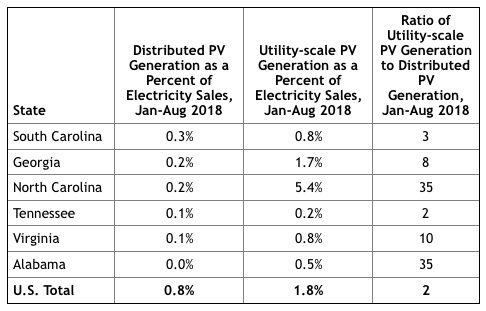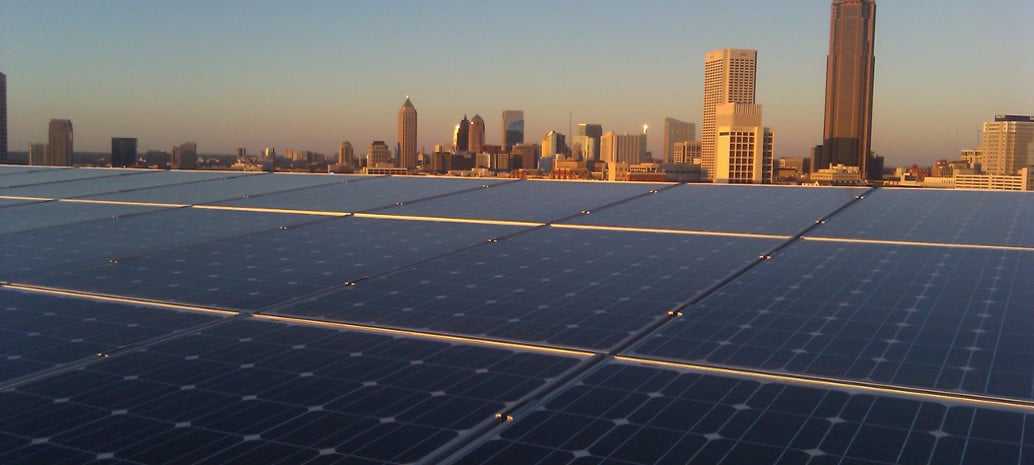The solar policies of more than 400 utilities in six Southern states, which can either “make” or “brake” solar growth, are now an open book, thanks to the Rates of Solar web tool published by the Southern Environmental Law Center (SELC).
Southern states are no exception to a national trend in which many utilities are receiving permission from regulators to impose fixed charges for customers with solar.
That’s despite the benefits of rooftop solar, including displacing or deferring polluting generating units, serving peak demand, and enabling deferral of grid investments, said SELC staff attorney Lauren Bowen in an email. Programs that encourage solar “inherently compensate for these benefits,” she noted, “whether through a policy determination or more granular calculations.”
For consumers interested in improving their utility’s solar policy, “a good first step is reaching out to your utility,” said SELC staff attorney Jill Kysor. Following that, she suggests contacting the utility regulator—or for a co-op, its directors, or for a municipal utility, the city council. “Finally, consumers concerned about how their utility is treating solar customers can reach out to local organizations focused on clean energy issues,” she said.
An SELC press statement highlighted three solar “maker” utilities:
- BARC Electric Cooperative in western Virginia, which enables customers to net-meter solar systems up to 20 kW in size, without fees.
- Duke Energy, which currently provides net metering for systems as large as 100 kW without fees—but which may seek to change its net metering policy in 2019.
- Brunswick EMC, in eastern North Carolina, which provides net metering “at a low monthly administrative fee.”

And SELC flagged three solar “braker” utilities:
- Alabama Power, whose monthly charge for customers with solar “eliminates at least 50 percent of the savings” from installing solar.
- The Tennessee Valley Authority, which regulates itself, and gives customers who want to add solar “two bad alternatives,” such that Tennessee is “falling far behind neighboring states.”
- Blue Ridge Energy, in northwestern North Carolina, which imposes an incremental monthly fee of $29 on customers with solar.

In none of the six states included in the web tool does distributed solar’s contribution to electricity sales come close to the national average, as shown in the pv magazine analysis below, based on U.S. Energy Information Agency data. Meanwhile, the ratio of utility-scale to distributed solar generation in the six states generally exceeds the national average, often by a wide margin.
 SELC supports policies that provide greater access to clean, renewable solar power, said Ms. Kysor. The nonprofit works in the six states included in the web tool, through policy work, litigation, and coordination with other advocacy organizations, consumer advocates, and utilities.
SELC supports policies that provide greater access to clean, renewable solar power, said Ms. Kysor. The nonprofit works in the six states included in the web tool, through policy work, litigation, and coordination with other advocacy organizations, consumer advocates, and utilities.
This content is protected by copyright and may not be reused. If you want to cooperate with us and would like to reuse some of our content, please contact: editors@pv-magazine.com.








That’s why it’s important to vote. In Florida, Amendment #1 would have given the utilities the power to impose fees on solar customers, but we beat it The dirty central power monopolies pumped $36M into false advertising to fool the common people, but it didn’t work. It’s time to end JP Morgan’s centralized power topology and move to DG which is clearly better for the people. Enphase Energy, SunPower, Solaria, Panasonic, LONGi, LG and Jinko are all moving in that direction with their AC Module products.